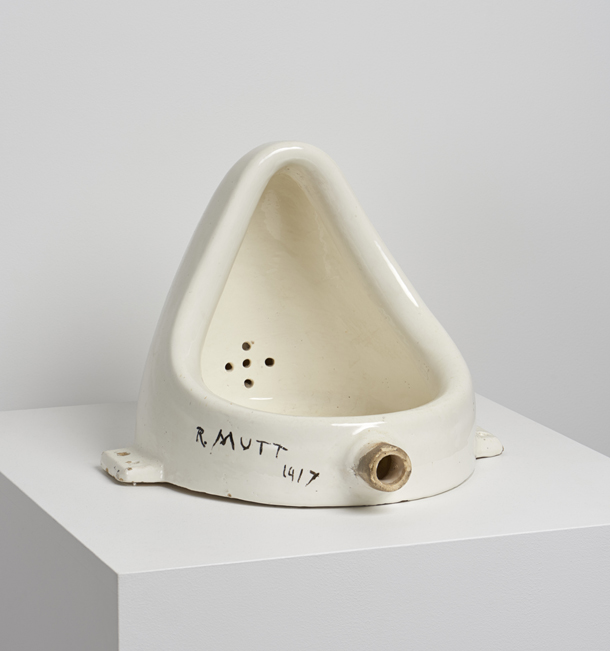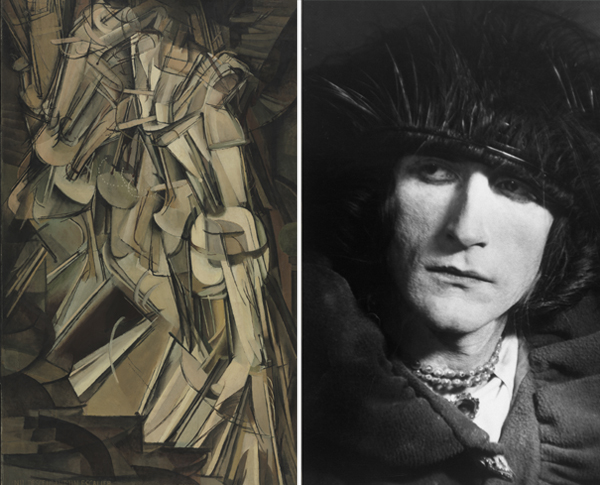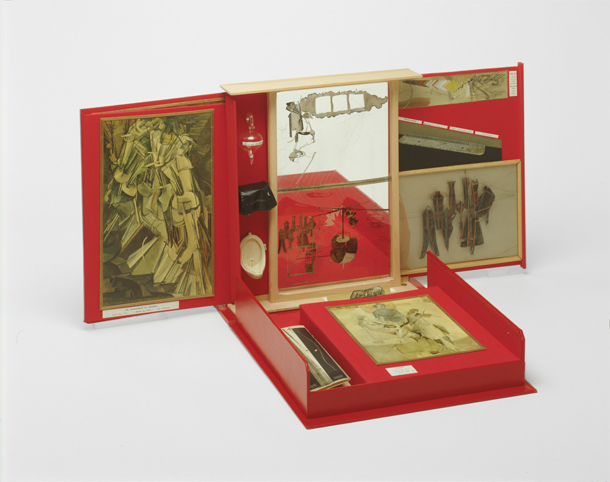Understanding Marcel Duchamp’s contributions to contemporary art: MMCA hosts the artist’s largest-ever retrospective in Asia

Marcel Duchamp’s 1950 replica of his iconic work “Fountain”(1917) is part of his retrospective in Korea at the National Museum of Modern and Contemporary Art (MMCA) in central Seoul. [ⓒ Association Marcel Duchamp /ADAGP, Paris - SACK, Seoul, 2018]
This doesn’t only show why Paik chose to explore video art, but also summarizes the great influence and the great burden Duchamp has given to the artists who followed him.
Now, Korean art lovers can see what makes Duchamp so inspirational and controversial at his largest-ever retrospective in the Asia-Pacific region, which starts on Saturday at the National Museum of Modern and Contemporary Art (MMCA)’s Seoul branch east of Gyeongbok Palace.
The exhibition has been co-organized by the Korean museum and the Philadelphia Museum of Art, which has the world’s largest collection of Duchamp’s works based on the collection of Walter and Louise Arensberg, who were Duchamp’s primary patrons.
The Korean exhibition features about 150 pieces from the U.S. museum, including the most famous (or notorious) “Fountain” and other Duchamp ‘readymades.’
The exhibit also includes the only Duchamp work in the MMCA collection - an edition of “Box in a Valise.” This is a portable set of miniature reproductions of Duchamp’s selected works for which he designed and controlled their production and distribution. Another edition from the Philadelphia Museum is on display next to the MMCA’s edition, making a spectacular view.
According to the MMCA, Duchamp originally presented “Fountain” - the highlight of the retrospective - in 1917 to the first exhibition of the Society of Independent Artists in the United States. He was working as a board member and intended to test the organization’s open-mindedness.
He chose a ready-made urinal, signed the pseudonym “R. Mutt” on it and displayed it under the title “Fountain.” After much debate by members of the board, they voted to not display the work in the show. Duchamp stepped down from the board in protest.
Duchamp wrote to the art and Dada journal “The Blind Man” to defend Mutt’s - or rather his - work. “Whether Mr. Mutt with his own hands made the fountain has no importance. He CHOSE it. He took an ordinary article of life, placed it so that its useful significance disappeared under the new title and point of view - created a new thought for that object.”
“Not only the urinal - the object, but his act, the viewers’ reactions and the debate make the work ‘Fountain,’” explained Lee Jihoi, curator of the MMCA, during a press preview on Thursday. “This is a characteristic of contemporary art that appeared decades later.”
Duchamp was one of the first artists to challenge the modern idea that an artwork must be created by the artist’s authentic touch and have the aura of the artist’s other self. Duchamp sought to question what the exact definition of art is. Thus, his work, “Fountain,” is not actually a urinal but a question itself. A concept became art in his work, making it one of the earliest examples of Conceptual Art, which appeared in earnest in the 1960s.
“He not only developed modern art in the first several decades of the 20th century, but also what [was] to come much later,” Timothy Rub, the director of the Philadelphia Museum of Art, said during a press preview.
The “Fountain” on view is actually a 1950 replica of the 1917 work, the earliest full-size replica, signed “R. Mutt,” again by Duchamp himself, because the original was discarded. However, if the essence of “Fountain” is a concept rather than a urinal, why did he made the replica?
Matthew Affron, the Muriel and Philip Berman Curator of Modern Art at the Philadelphia Museum, explained, “In the 1950s and 60s, as Duchamp’s public profile expanded very quickly, there was a great demand for an exhibition of replicas of his earlier works. So it was simply a response to demands.”
“And Duchamp was very happy because they created further twists on all the ideas about the original, the first and the valuable ones in art, which he had already twisted with the readymade,” he added. “He said he was happy to sign many replicas because the more he signed, the more the objects will be devalued.”
The retrospective is arranged chronologically and divided in four sections. The first section “A Painter’s Life” features Duchamp’s paintings from his teens and early 20s, which show his experimentation with various modern art movements including post-Impressionism, Symbolism, Fauvism and Cubism. Viewers may be surprised by his excellent painting techniques and realize that his fondness for found objects was not due to a lack of technical skill.

Duchamp’s painting “Nude Descending a Staircase (No. 2)” (1912), left, and Man Ray’s photograph “Duchamp as Rrose Selavy” (1921) are also part of the retrospective. [ⓒ Association Marcel Duchamp /ADAGP, Paris - SACK, Seoul, 2018]
The second section is titled after Duchamp’s important question, which later changed art history; “Can works be made that are not ‘of art?’”
The section features works including the 1964 replica of “Bicycle Wheel” (1913), the first of his ‘readymades,’ the 1961 replica of “Bottlerack” (1914), as well as “Fountain.” There is also a video piece about the monumental construction, “The Bride Stripped Bare by Her Bachelors, Even (The Large Glass),” which could not leave the Philadelphia Museum, on view.

“From or by Marcel Duchamp or Rrose Selavy (Box in a Valise)” is a leather valise containing miniature replicas and color reproductions of works by Duchamp. [ⓒ Association Marcel Duchamp /ADAGP, Paris - SACK, Seoul, 2018]
Among the exhibits in this section are American artist Man Ray’s photographs of Duchamp dressed as a woman - Rrose Selavy - which gives the strange impression of the “third sex.” “I don’t think that Duchamp was operating in the notion of the third sex. I’ve seen no evidence for that,” Affron said. “But he was very open-minded to interpretations.”
In the same section are two editions of “Box in a Valise,” whose original title is “From or by Marcel Duchamp or Rrose Selavy,” which alludes to the situation of Duchamp having to leave Paris again for New York, this time to escape World War II, and his concerns about the preservation of his works.
The fourth and final section “Our Lady of Desire” features drawings, small sculptures and photos made by Duchamp during the process of creating the room-sized diorama “Etant donnes.” This erotic and mysterious work is permanently installed in the Philadelphia Museum and visitors to the MMCA exhibition can see how it looks through a video piece.
“Etant donnes” is a tableau, which depicts a nude woman lying in a bush with her face hidden, legs spread, holding a gas lamp in the air in one hand against a landscape backdrop. It is made of various mediums and visible only through a pair of holes in a wooden door. It offers a new experience to museum visitors “by disturbing their usual behaviors in museums,” Affron said.
Duchamp secretly worked on it from 1946 to 1966 as “a final artistic statement” according to the MMCA, while it was believed he had essentially retired as an artist. According to the artist’s wishes, the work was only put on view in 1969, after his death.
“Marcel Duchamp continues to fascinate artists and scholars in our own time,” Rub, the director of the Philadelphia Museum of Art, said in the press preview. “We cannot understand much of contemporary art without understanding Duchamp himself and his art.”
BY MOON SO-YOUNG [symoon@joongang.co.kr]
Admission is 4,000 won ($3). Go to Anguk Station, line No. 3, exit 1, and walk for 10 minutes. For details, visit www.mmca.go.kr or call (02) 3701-9500.










with the Korea JoongAng Daily
To write comments, please log in to one of the accounts.
Standards Board Policy (0/250자)